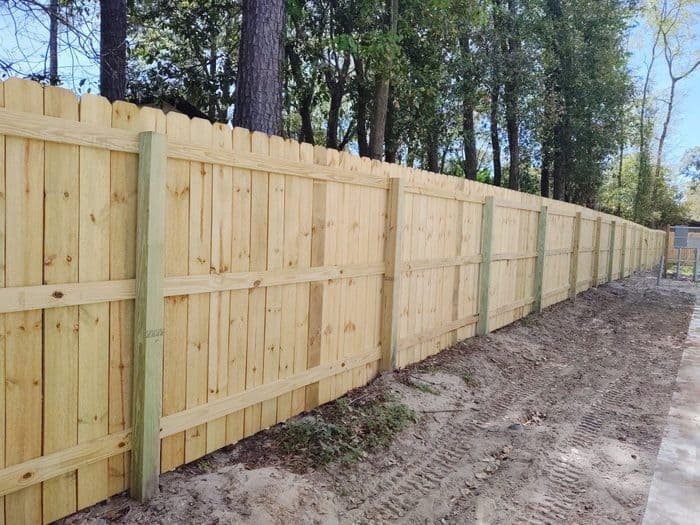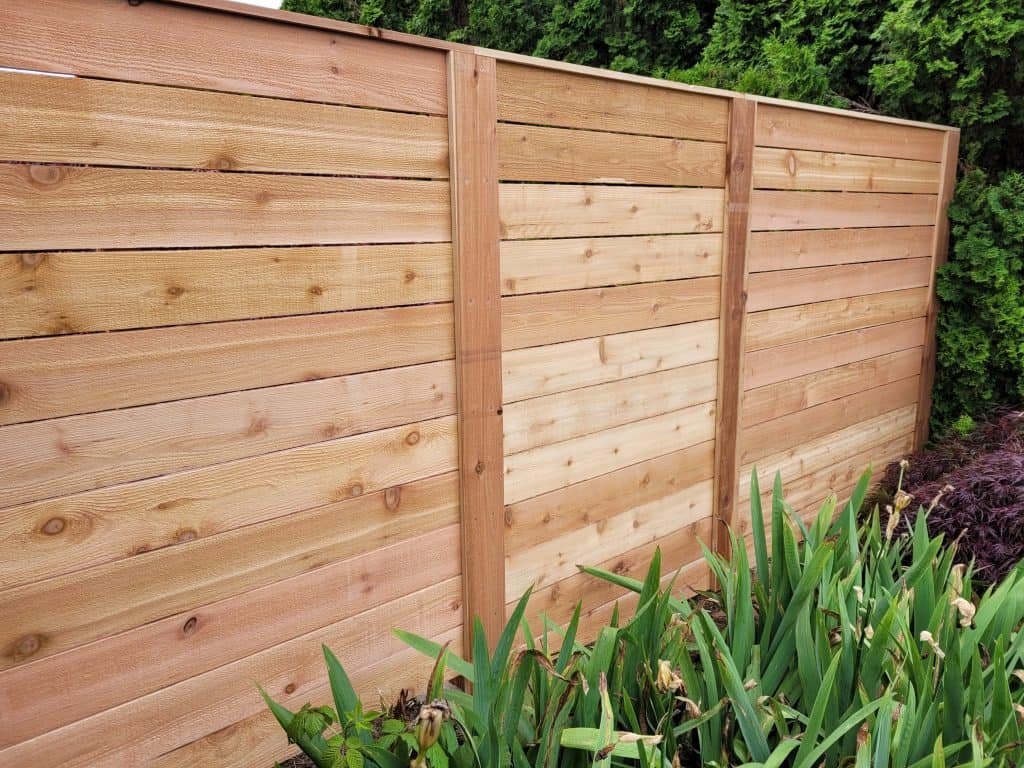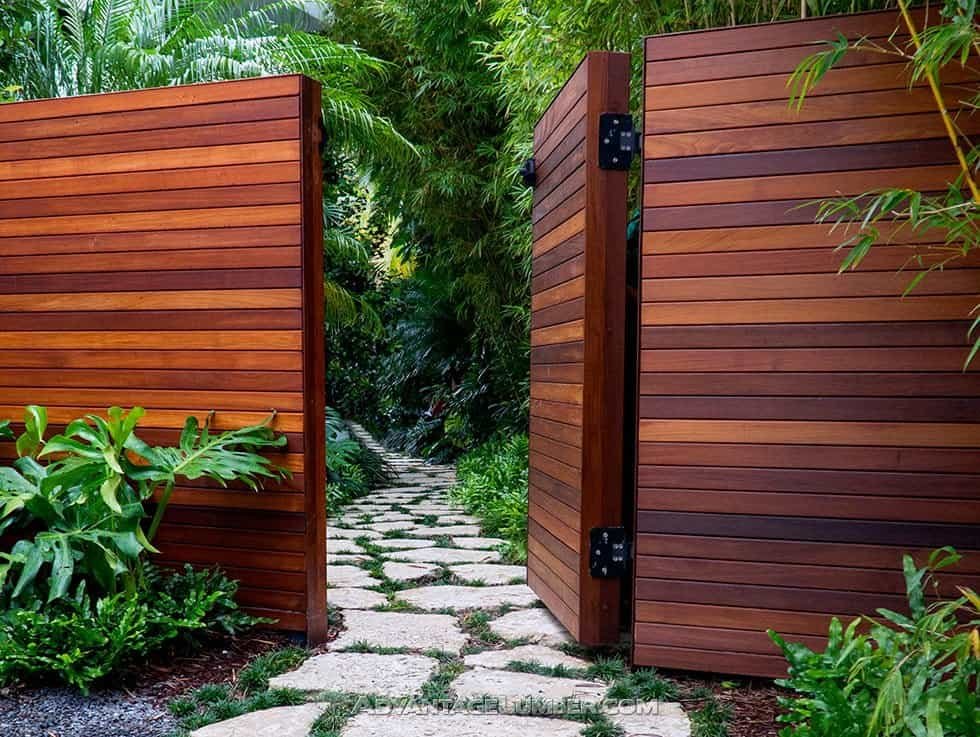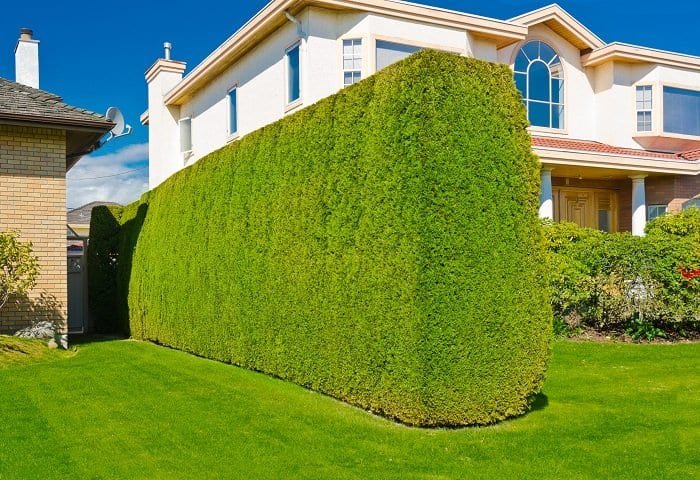How Long Does a Wooden Fence Last
Are you in the market for a new fence and want to know how long a wooden fence lasts? If so, you’re in the right place, we’ll discuss how long a wooden fence lasts and how to make it last longer.
The simple answer for how long a wood fence lasts is 10-30 years. I know that’s a big range but there are several variables that goes into an outdoor fence lifespan. The biggest variables are listed below.
- Type of Fence Pickets
- Location of fence (sunny vs shaded)
- Vegetation around fence
- Custom made vs Premade Panels
- Proper fence building techniques
- Protective coating applied vs. no stain/sealer
A typical scenario is a cedar fence properly built in a sunny location with a frequent stain application schedule should last 20+ years.
This is the top of the lifespan range, but on the bottom range would be a pressure treated wooden fence located in a shady high humidity area with vines growing on it, and without any annual maintenance. That fence even if properly built will only last 5-10 years.
As you can see, how long a wooden fences last can be highly subjective. Most of the time it will boil down to how much maintenance your fence gets annually as to how long it will last. Let’s discuss the factors that you can control from the list above.
Table of Contents
Wood Used For Fencing Pickets
Most backyard wooden fence frames built today are made with 2×4 pressure treated pine rails and 4×4 posts. The biggest variable is the type of wood used for the fence pickets. Let’s discuss the difference of each of the following woods and their longevity when used as fence pickets.
Pressure Treated Pine Fence Pickets

Most of the big box store carry pressure treated pine pickets and it is probably the most used simply due to availability and price. The treatment makes it more resistant to rot from insects. However, during the drying process, it can shrink and warp severely.
| Pros | Cons |
|---|---|
| Cheap | Can warp and shrink easily |
| Available everywhere | maximum lifespan of 10-12 years |
| repels insects through treatment process | High yearly maintenance |
Cedar, Cypress and Redwood Fence Pickets

The second most used type of fence pickets is cedar, cypress or redwood depending on where you live. These three woods repel insects with natural oils. They are also make a very nice looking fence pickets with beautiful grains and colors.
They will not warp as easily as pressure treated pine and can be stained/sealed right after installation. With proper maintenance, these woods can close to 30 years.
| Pros | Cons |
|---|---|
| Up to 30 year lifespan with proper maintenance | Selective Availability |
| Naturally repels insects | Costs 2-3x more than pressure treated pine |
| Beautiful grains and colors |
Hardwood Fence Pickets

Higher end fences built with hardwood species such as Ipe, Teak or Cumaru will last 40-50 years. The cumaru fence shown above from advantage lumber is a good example of how beautiful a fence built with hardwoods can be. While they are certainly beautiful and very durable, they will also be the most expensive.
A 1x6x6 cedar fence picket costs close to $4, while a 1x6x6 Ipe fence picket will cost $40-50 each. If you only want to build one fence in your lifetime and have the extra cash, an Ipe fence is the way to go.
| Pros | Cons |
|---|---|
| 40-50 year lifespan | Very expensive |
| Beautiful colors | Harvested from rainforests |
| Naturally repels insects and wet weather | |
| Little to no maintenance required |
Premade Panels vs. Custom Built Fence
Premade wooden panels are one of the easiest fences you can install yourself. They will save you time and money, but they will not last as long as a custom made fence.
This is mainly due to the thickness of the materials used for premade panels. Even in an optimized environment a premade panel may only last 10 years.
Many people may not realize that premade panels found at the big box store are made with 1/2 inch thick fence pickets. Compare that to 5/8 or 3/4 thick individual pickets. The thinner pickets will shrink and warp faster as well as not last as long.
Also, the rails used many times are only 2x3s rather than 2x4s. The 2x3s will start to sag over time over an 8 foot span causing your entire panel to fail.
Proper Fence Building Techniques
We have a lot of articles on fences since it’s one of the main hardscapes in your backyard. We go into detail on proper building techniques, no matter the style of fencing you choose. Whether you choose to build a traditional vertical fence or a modern horizontal fence, each will last a long time if properly built.
The biggest aspect of proper fence building is installing your fence posts and rails correctly for a long lifespan. A proper fence post installation will use gravel underneath to prevent water from rotting the post.
A good fence rail installation will use appropriate hardware that withstands the weight of the rails and pickets over a long time.
Using the proper screws or nails to install your fence pickets will help keep the picket properly fastened to the rail even with any shrinkage or warping.
Regular Staining/Sealing Fence
This aspect alone can determine how long your fence lasts especially if using pressure treated pine as your fence pickets. You could length your fence lifespan by 10 years or more simply by staining it regularly.
The cheaper the wood material you choose to build your fence will determine how much time you will need to maintain your fence for a longer lifespan.
If your fence has a lot of vegetation around or if it doesn’t get a lot of sun, keeping it stained will protect it from rotting sooner. Let’s discuss exactly what you should do to make your fence last longer.
How to Make Your Wooden Fence Last Longer
Let’s go through some very simple steps you can take to keep your wooden fence looking good and lasting longer.
Clean/Power washing A Wooden Fence
Each Spring you should power wash your fence or hire someone to clean your fence. It’s a great weekend project and will provide you with instant gratification to see clean brown fence pickets. Power washing or scrubbing your fence will get rid of mold and mildew which causes wooden fences to rot quicker.
Staining A Wooden Fence
Once you’ve cleaned your fence, you are ready to add a layer of stain/sealer to protect it next year against any further mold and mildew growth. The stain will also protect from the degradation caused by UV rays.
If you have any fence pickets that are close to the ground, make sure to stain/seal the bottom edges. Remove any dirt that is touching the fence pickets as they will rot quicker by wicking up the moisture any time it rains.
If you have dogs, we showcase several ways to deter dogs from digging underneath your fence.
Painting a Wooden Fence
While you think paint is a good option to protect your fence pickets, it can actually make it rot raster if not applied properly and maintained regularly.
Paint can actually trap water underneath causing the fence picket to rot much faster. If you like the look of a painted fence, we recommend using a solid stain instead.
The stain penetrates the wood rather than sitting on top of it and you can choose any color imaginable.
Signs You Need a New Fence
Maybe you just bought a house and trying to determine if your current fence is worth saving vs building a new fence. If your current fence frame is in good shape, you may just need to replace a few boards here and there.
The biggest indicator of needing a new fence is the condition of your fence framing. If your fence has sagging rails or leaning and unstable posts, more than likely you need a new fence.
FAQs
How often do wood fences need to be replaced?
If your fence is older than 10-15 years, you may be contemplating replacing it. If your fence is made from pressure treated pine, you probably need to replace it. If your fence frame is still in good shape you may be able to just replace the fence pickets.
How do I keep my wooden fence from rotting?
Maintaining your fence by cleaning and staining will prolong the life of your fence. If your fence doesn’t get a lot of sun, you will need to clean and stain it more often to keep mold and mildew at bay.
What is the best time of year to install a fence?
The best time to install a fence is when the weather is agreeable, not too hot and not too cold. Preferably during the dry season.
What type of wood fence last longest?
A fence made out of hardwood materials like ipe or cumaru will last the longest.
Does painting a wood fence make it last longer?
Yes, if you did the proper prep beforehand. If not, the paint could seal water inside making the fence rot faster. Find out the proper way to paint your fence
How often should you seal your wooden fence?
If you live in a wet environment, you will need to seal or stain your fence every 1-2 years. Same goes for a high dessert location that gets a lot of UV rays. If you live in a more temperate climate, you many only have to stain every 4-5 years.
Is a wood fence worth it?
A wood fence is a great choice for privacy in your backyard if you don’t want your neighbors knowing every time you go outside. If you have dogs, it also keeps them contained rather than having to leash them every time you go in your backyard.
Are wood fences hard to maintain?
No, but it does take time to clean and stain your fence regularly.
How long will a wood fence last without staining?
That depends on the type of fencing you have and where it’s located. Pressure treated pine fence pickets may only last 5-10 years without staining located in a wet location.
How long before a wood fence turns grey?
The more sun your fence gets, the faster it will turn grey. If you fence is located in full fun, it could turn grey within several months.






